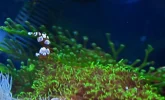little_fish
Reef pro
Scientific name - Thor amboinensis
Family – Hippolytidae
Common name – Anemone Shrimp
Range - Indo-Pacific, Indonesia
Max Size – 1 in (2.5 cm)
Care Level – Easy
Temperament – Peaceful
Foods and feeding – This shrimp will scavenge food from the aquarium, but will appreciate small treats of meaty bits.
Supplements - Calcium, Magnesium, Iodine, Trace Elements
Aquarium suitability -
Reef Compatibility – yes
Author's Note: While considered by most to be reef safe, I would consider them reef safe with caution. Two of the shrimp that I had were notorious coral eaters, the especially enjoyed trying to eat my plate coral. I had to keep a small PVC pipe by the tank to shoo them away from the plate coral. They particularly enjoyed eating LPS and a few SPS corals, however moving the coral away from their "house" fixed the problem. I believe they were trying to clean off the slime coat of the corals, like they would from a host anemone, but instead of benefiting the coral, their attentions resulted in tissue necrosis.
Captive care – Their name comes from the dance they do. They are hosted by SPS corals and anemones, but don’t require them for survival. They do best when kept in a group and in a small tank with inhabitants that wont eat them. They are hardy and fun additions to a nano tank. Like all invertebrates, they are extremely sensitive to nitrates and copper, and should only be kept in aquariums with pristine water conditions.
Family – Hippolytidae
Common name – Anemone Shrimp
Range - Indo-Pacific, Indonesia
Max Size – 1 in (2.5 cm)
Care Level – Easy
Temperament – Peaceful
Foods and feeding – This shrimp will scavenge food from the aquarium, but will appreciate small treats of meaty bits.
Supplements - Calcium, Magnesium, Iodine, Trace Elements
Aquarium suitability -
Reef Compatibility – yes
Author's Note: While considered by most to be reef safe, I would consider them reef safe with caution. Two of the shrimp that I had were notorious coral eaters, the especially enjoyed trying to eat my plate coral. I had to keep a small PVC pipe by the tank to shoo them away from the plate coral. They particularly enjoyed eating LPS and a few SPS corals, however moving the coral away from their "house" fixed the problem. I believe they were trying to clean off the slime coat of the corals, like they would from a host anemone, but instead of benefiting the coral, their attentions resulted in tissue necrosis.
Captive care – Their name comes from the dance they do. They are hosted by SPS corals and anemones, but don’t require them for survival. They do best when kept in a group and in a small tank with inhabitants that wont eat them. They are hardy and fun additions to a nano tank. Like all invertebrates, they are extremely sensitive to nitrates and copper, and should only be kept in aquariums with pristine water conditions.
Attachments
Last edited:

